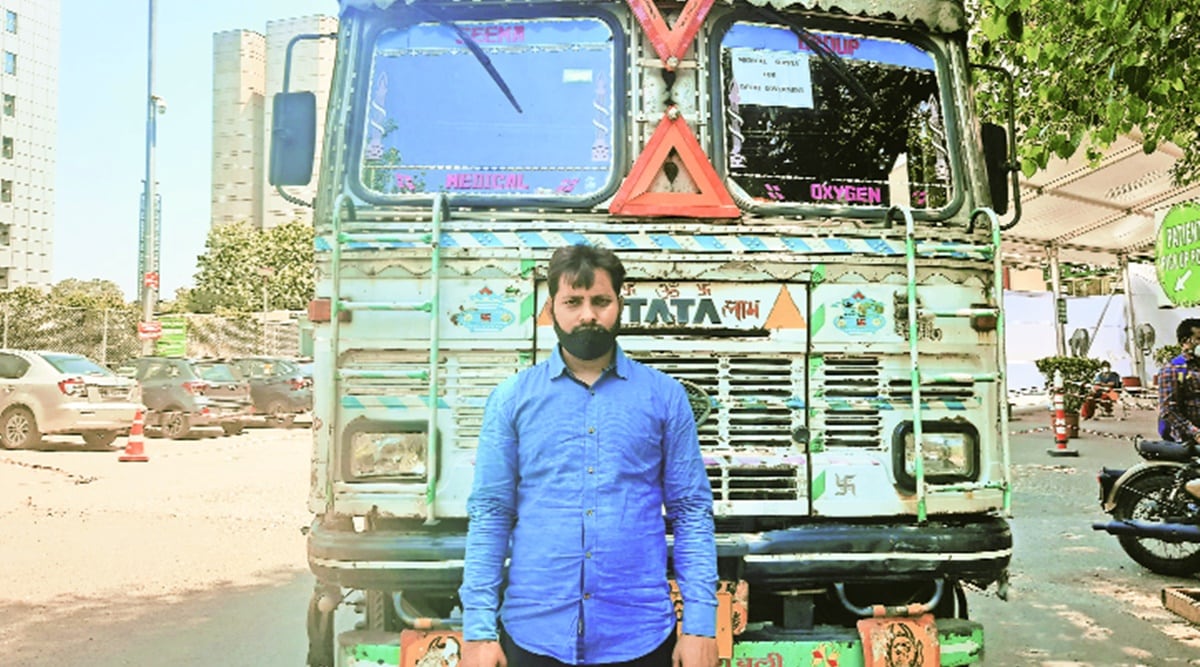 Anurag Tiwari, an oxygen tanker driver, says he never thought his job would be this crucial. Tiwari works for the Seema Group, a private firm that supplies medical oxygen. (Express Photo by Ashna Butani)
Anurag Tiwari, an oxygen tanker driver, says he never thought his job would be this crucial. Tiwari works for the Seema Group, a private firm that supplies medical oxygen. (Express Photo by Ashna Butani) As 27-year-old Anurag Tiwari drove his oxygen tanker inside the gates of Sir Ganga Ram Hospital at 12.09 pm on Sunday, almost everyone from security guards to relatives of patients breathed again.
As Delhi grapples with an acute shortage of medical oxygen and hospitals move the High Court and beg for help on social media, men like Tiwari have been delivering literally the gift of life to hundreds of patients seriously ill with Covid-19.
Tiwari works for the Seema Group, a private company that supplies medical oxygen from plants in Roorkee or Bawana to hospitals in Delhi. He had started out for Roorkee, some 210 km away in Uttarakhand, at 10 am on Saturday, and had reached the plant at 3.30 pm.
It had taken him a few hours to fill the tanker and complete paperwork, after which he had immediately got back on the road to Delhi.
Tiwari and his two helpers were told to head to Lok Nayak Hospital, Ganga Ram, City Hospital, and Metro Hospital, all of whom had reported they were dangerously low on oxygen supplies. While on the way to Lok Nayak, however, they had received an urgent call asking
them to go to Apollo Hospital first.
“We have been getting many such emergency calls,” Tiwari said. Neither he nor his colleagues — technicians and helpers — had ever imagined their job would become this critical one day, Tiwari said.
Tiwari has not gone home to Azamgarh in Uttar Pradesh for six months now. His companion Ravinder (27), said, “I can’t remember the last time I saw my one-year-old daughter.”
Earlier, they used to be on duty for eight or nine hours every day, Ravinder said. “Nowadays, we work round the clock. During the day, we take naps for one or two hours if we can afford to,” he said.
Men like Tiwari and Ravinder receive their “programme for the day” from government officers every morning. It’s a list of locations and hospitals that they have to deliver to. The amount of oxygen that they deliver is determined by officials based on the hospital’s requirement, Tiwari said.
Often, hospital staff offer them tea or perhaps a meal. They almost always decline — there is always a hospital waiting, and when it is a matter of life and death, there is never a moment to lose.
At Rajiv Gandhi Hospital, four technicians are at work round the clock on the Medical Gas Pipeline System (MGPS). This room contains the nuts and bolts of the hospital’s oxygen system — cylinder manifolds, alarm systems, and medical compressed air systems. Like the tanker drivers, for these technicians too, the crisis has meant endlessly long hours, shorter breaks, and many added tasks.
While the systems are mostly automated, three technicians and a supervisor must be present to ensure that nothing goes wrong. Technicians at the hospital said oxygen consumption has gone up from the usual 500 millimetres per water column (mmwc) a day to at least 5,000 mmwc daily. Once consumption reaches 2,000 mmwc, they start making calls to companies to seek stocks of oxygen. Alarms start sounding in the room when the line pressure is low.
“We used to work eight hours; now we are working 12 hours. Sometimes when there is a complaint, we visit the Covid wards to ensure they are receiving oxygen,” said Ajay Shukla (29), one of the technicians.
At 2.40 pm on Sunday, Shukla’s colleague Kaushal Kishor Dubey (27) visited the tank outside to assess the situation. “The administration has access to details online. But I have to conduct hourly checks to be absolutely sure. Right now, the oxygen consumption is at 3,500 mmwc. At this rate, we will last till tomorrow. A tanker will reach early morning.”
He has been working for three days straight, with occasional breaks, Dubey said.
- The Indian Express website has been rated GREEN for its credibility and trustworthiness by Newsguard, a global service that rates news sources for their journalistic standards.

